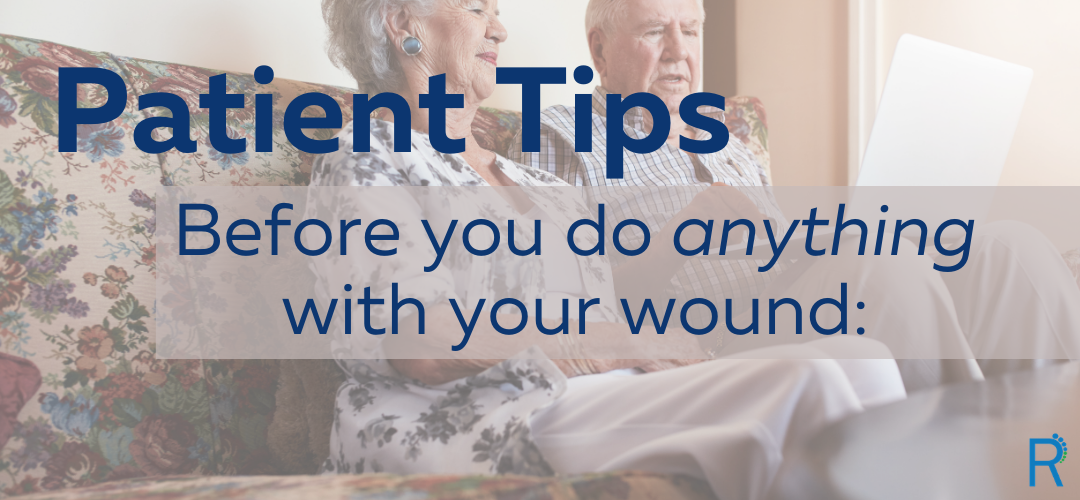Stepping Into 2021 with a Fresh Start: 7 Habits for Highly Effective Wound Care



As we begin this New Year we have an opportunity to begin with a fresh start as we pursue our passion to promote and speed the healing of wounds! Our role as Wound Care Clinicians has risen to a whole new level of essential care for an extremely high risk population.
In this current Covid-19 climate that we are living in, we are all facing challenges that we have never dealt with before. Individuals with chronic wounds (diabetic foot ulcers, pressure ulcers, venous ulcers, arterial ulcers, etc.) commonly have other chronic conditions – typically type 2 diabetes, hypertension, venous insufficiency, peripheral arterial disease, and/or chronic kidney disease. This cohort of fragile patients is high risk if they develop COVID-19, but are also high risk for increased morbidity and mortality – loss of limb or life. (Alliance of Wound Care Stakeholders)
Whether the patient is being seen by home health visit, in a clinical setting or a telehealth visit, the importance of consistent evaluation and follow up treatment is critical. Although the practices listed here are much like “preaching to the choir,” it’s always a good idea to review the basics.

Back to the Basics: Helpful Clinical Tips
- Knowledge is Power: Educating the patient and care giver is foundational for successful outcomes. A baseline assessment of their current knowledge is essential. Also, establishing who will be the point of contact for follow up is necessary for continuity of care. Families need to at least know the basics of wound care i.e.: wound care / dressing technique, infection control practices and nutrition to handle their loved ones at home.
- Build a Partnership: Staying connected with patients and caregivers will help reduce stress levels, raise confidence levels, reduce the risk of infection and ultimately improve outcomes. Teddy Roosevelt once said,

There is much wisdom in this statement. Time constraints seem to be one of our biggest challenges as we navigate through our hectic schedules on a daily basis! However, if we can simply do our best in each moment to be kind, sincere, good listeners… it goes a long way in making someone feel valued. - Instructions on wound care: Arrange for as many caregivers to be present as possible for the demonstration. Remember the simpler the directions the better. Have the patient or caregiver do a return demonstration. Provide handouts, booklets or videos as a resource to refer to and for additional education. Provide contact information so that the patient or caregiver has quick and easy access to get questions or concerns answered.
- Prevention of Infection: Strategies for prevention of infection in wounds both acute and chronic begin with the principles of wound bed preparation. Appropriate cleansing, frequent glove changes, debridement practices, and choice of topical interventions are necessary components of effective wound bed preparation. When debris and foreign material are present in a wound bed, fewer organisms are required to produce an infection. Removal of these substances and of devascularized and necrotic material improves the host defense mechanisms. (Barrett S. Wound-bed preparation: a vital step in the healing process. Br J Nurs. 2017;26(12):24-31. doi: 10.12968/bjon.2017.26.12.S24.)
Patient Tips: Before you do anything with your wound:
-
-
- Wash your hands for 20 seconds from the wrist down with water and antibacterial soap. Rinse well.
- Dry your hands with a CLEAN paper towel or towel.
- Rub your hands together quickly for 20 seconds.
- Only touch your dressing with clean, just washed hands.
- Use gloves.
- Keep urine, stool, and other body drainage away from your wound.
- Keep your wound covered with a dressing at all times. The dressing protects the wound from dirt and bacteria, controls the drainage, and keeps medications on the wound.
- Choose a clean, well-lit place with a washable surface to do your dressing changes.
- Keep your dressing supplies away from the heat in a clean closed container. You can use a plastic box with a lid and keep the box off the floor.
- Throw your old used dressings away. Wrap them in two plastic bags and tie it tightly. Throw them away in a closed trash can. (Healogics.com Infection Prevention and Management)
-
- Nutritional Support: When someone has a wound and/or an infection they will need extra protein, calories and nutrients. A nutritional might be in order. It’s important to eat well in order to heal well. Power foods, along with higher amounts of calories, include protein, vitamins A and C, and sometimes zinc. Protein is used to build, maintain and repair body tissues. It is also very important to make sure the patient is eating a balanced diet to prevent any vitamin and/or mineral deficiencies; these are needed to help build and maintain new tissues. If the patient is not able to meet their nutritional needs through diet alone recommend oral nutrition supplements. Many varieties are available that provide extra calories, protein, vitamins and minerals in both flavored and unflavored options. (Cleveland Clinic)
- Documentation:
-
- Location: Use the correct anatomical terms to clearly document the wound’s location.
- Type of Wound: Many types of wounds can be assessed and documented, including surgical wounds, burns, and pressure injuries. Wounds can also be acute or chronic.
- Measurement: The size of the wound should be measured in centimeters and listed in the wound care treatment chart as length times width times depth. Nurses must also document the location and depth of any tunneling or undermining.
- Wound Bed: It’s important to document tissue type (slough, eschar, epithelial, granulation, etc.), coloring, and level of adherence using percentages. For example, “40% of the wound is covered in non-adherent tan slough while 60% is covered with red granulation tissue.”
- Wound Edges: Indicate whether a wound’s edges are defined or undefined, attached or unattached, rolled under, macerated, fibrotic, or callused.
- Drainage: The amount and type of drainage must be documented in a wound care assessment. Common types of draining include serous, sanguineous, serosanguineous, and purulent. Words like “none,” “scant,” “small,” “moderate,” and “large/copious” are often used to describe the amount of drainage assessed.
- Odor: Wounds can have different odors, including those that are strong, foul, pungent, fecal, musty, or sweet. Some have no odor at all.
- Surrounding Tissue: Describe the color, firmness, and pallor of the surrounding skin. Note any signs of edema or induration, as well as any lesions, scarring, rashes, staining, moisture, or variations in texture.
- Infection: Wounds are often prone to infection, which can significantly disrupt the healing process. A wound assessment should cite any indicators of infection, including redness or localized pain.
- Take Care of Yourself: To be able to care for your patients and the people you love, you must first take care of yourself. Healthcare providers are often inclined to put self-care on the back burner as they care for others. It’s a natural instinct as a care provider to just “keep going”, but during this unprecedented time of crisis we must adjust our mindset. The “new norm” leads each of us to this realization quickly; whether we are on the front lines or playing in the backfield supporting our front-line heroes. The thought of self-care seems… almost laughable. However, paying attention to your own physical and emotional health enables you to handle the challenges of supporting and caring for others. Maintaining physical and mental health makes one more resilient, able to weather hard times and enjoy the good ones. (www.CipherHealth.com)
This blog post was written by Liz Silvestri, RN
Nurse consultant for EO2.
What is an RN? RN stands for “registered nurse". An RN is a clinician with a nursing degree who has passed a licensing exam.

